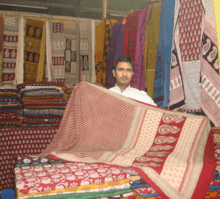Dastkar
Dastkar is an Indian non-government organisation working with craftspeople across India, for promotion and revival of traditional crafts of India.[2] It was founded in 1981 in Delhi, by a group of six women, including Laila Tyabji, its current chairperson.[3]

| Formation | 1981 |
|---|---|
| Type | NGO |
| Headquarters | Kisan Haat, Andheria Morh, Mehrauli Delhi-74 [1] |
| Services | crafts promotion |
Chairperson | Laila Tyabji |
| Website | www |
Today, it is synonymous with the Dasktar Mela, a crafts exhibition it organises every year since 1982.
History
Dastkar started working started with 15 crafts groups in 1981, and 30 years later it is associated 350 craft groups across India.[4] Over the years, Dastkar has worked in women empowerment in rural areas, where it has been involved in developing self-reliant artisan groups.[5]
In 2005, Tyabji became a founder-member of All India Artisans and Craft Workers Welfare Association (AIACA), along with Pritam Singh (Anokhi), Ritu Kumar, Madhukar Khera and Fabindia.[6] She was awarded the Padma Shri by the Government of India in 2012.[7]
Dastkar Mela
Dastkar started organising the annual "Dastkar Mela", the crafts fair and exhibition during the autumn, preceding the autumn festive seasons, and Diwali. Held in Delhi, the mela sees craftspeople and artisans from over 22 states selling their works and crafts items. Besides this, it also features workshops and demonstrations by the artisans.[8]
Dastkar Nature Bazaar
In 1983, it started organising the "Dastkar Nature Bazaar" after environmentalist Valmik Thapar suggested the idea of promoting natural materials and fibres, along with nature-inspired products with nature motifs and images of birds and animals. Over the years, it has been held at various locations in Delhi, including the Dilli Haat, Crafts Museum, Delhi, Indira Gandhi National Centre for the Arts (IGNCA) and Kisan Haat in Mehrauli.[9][10] In 2012, the Kisan Haat in Mehrauli was taken on a 15-year lease from Delhi Tourism to organize where theme-based bazaars, this included South Asian Bazaar, Winter Weaves, and Basant Bazaar. Here regional and speciality cuisines from various parts of India has also been featured[4]
Similar Dastkar Bazaars are now organized in many parts of the country, where craft groups and different states display and sell the works.[11]
References
- Handicrafts India Yearbook. Handicrafts India. 1990. p. 355.
- Tankha, Madhur (9 August 2013). "Neighbourhood handicrafts at Delhi Dastkar bazaar". Chennai, India: The Hindu. Retrieved 25 October 2013.
- "Organization". Dastkar. Archived from the original on 29 October 2013. Retrieved 25 October 2013.
- Tripathi, Shailaja (24 October 2013). "Just the way it is…". Chennai, India: The Hindu. Retrieved 25 October 2013.
- Ajit Kumar Sinha (1 January 2008). New Dimensions of Women Empowerment. Deep & Deep Publications. pp. 529–530. ISBN 978-81-8450-089-9.
- Singh, p. 251
- "Padma Awards Announced". Press Information Bureau, Ministry of Home Affairs. 25 January 2012.
- "Delhi gets crafty at the Dastkar mela". Hindustan Times. 9 October 2011. Archived from the original on 31 October 2013. Retrieved 25 October 2013.
- "Dastkar showcases Indian traditions". The Times of India. 29 October 2010. Retrieved 25 October 2013.
- "The Hindu : New Delhi News : Celebrating nature and craft: 14th Nature Bazaar opens at Dilli Haat". Chennai, India. 21 December 2007. Retrieved 25 October 2013.
- "Dastkar comes calling: Annual exhibition". Deccan Chronicle. 25 October 2013. Retrieved 25 October 2013.
Bibliography
- Radhika Singh (2010). The Fabric of Our Lives: The Story of Fabindia. Penguin Books India. ISBN 978-0-670-08434-0.